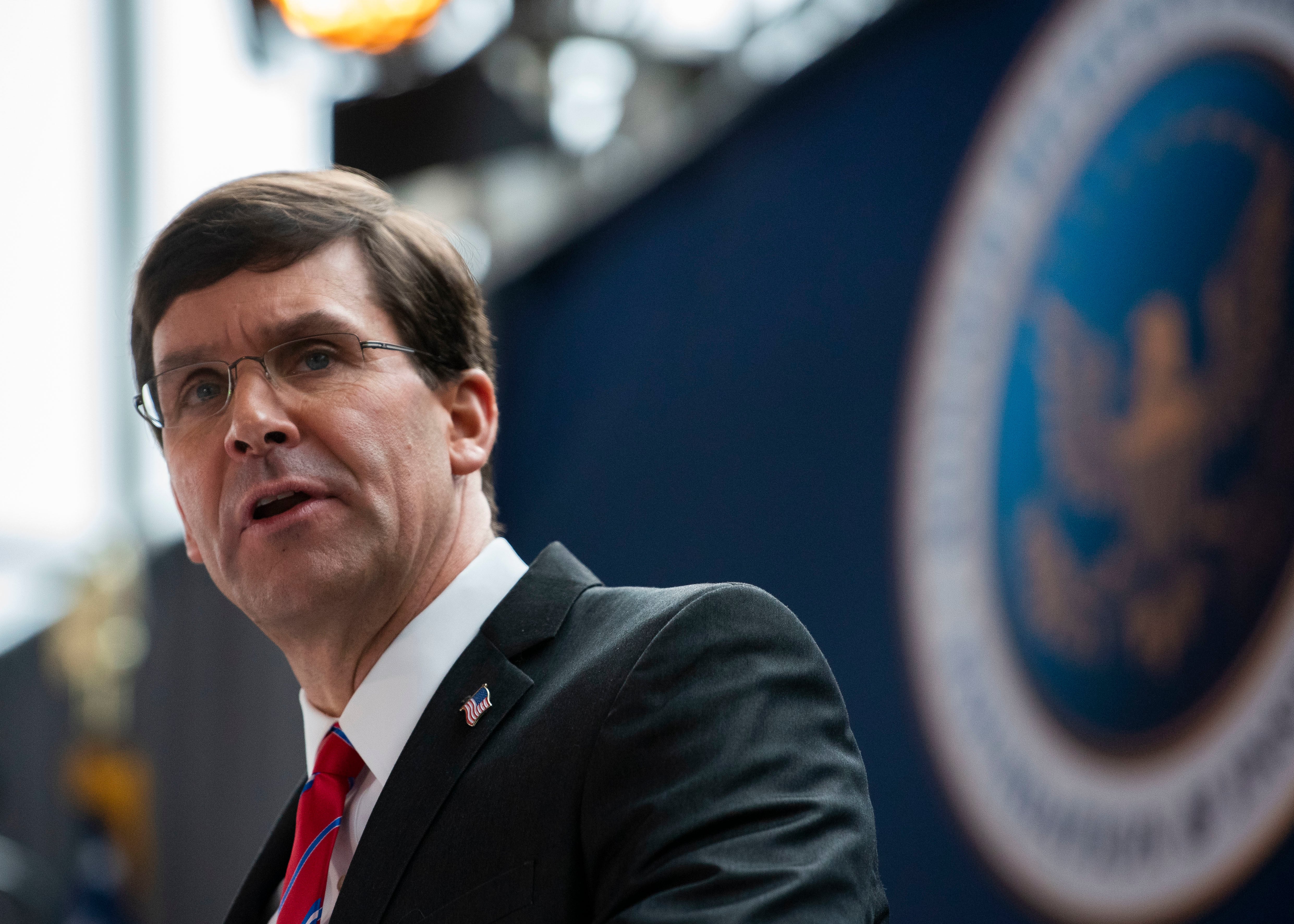WASHINGTON — U.S. President Donald Trump’s defense budget request for fiscal 2021 includes major investments in research and development portfolios as well as “crucial” technologies as part of what the Pentagon is branding an “irreversible implementation” of the National Defense Strategy.
However, the budget also features overall cuts to the Army and Navy top lines, as well as the divestment of legacy platforms from the Air Force.
The president is requesting $705 billion for the Defense Department, including $69 billion in overseas contingency operations, or OCO, wartime funds. Total national security spending, including for the National Nuclear Security Administration and other outside agencies, is $740 billion, as set by a congressional budget agreement last year.
Click here for more FY21 budget coverage.
Although not included in the budget documents, total top-line projections over the Future Years Defense Program, or FYDP, are $722 billion in FY22, $737 billion in FY23, $753 billion in FY24 and $768 billion in FY25, according to a senior defense official.
Service budget top lines are $178 billion for the Army, a drop by $462 million from FY20 enacted levels; $207 billion for the Navy, down $1.9 billion from FY20; and $207 billion for the Air Force, up $1.7 billion from FY20. The budget also requests $113 billion for defensewide efforts, which includes the so-called fourth estate agencies, down $6.5 billion from FY20. Overall procurement funding sits at $136.9 billion.
The OCO request of $69 billion is down dramatically from last year’s $164 billion, and it comes in three flavors:
- $20.5 billion in “direct war requirements,” or funding for combat operations that will end at some point in locations like Iraq and Syria.
- $32.5 billion in “enduring requirements,” which covers funding for the sustainment of bases, as well as pots of money like the European Deterrence Initiative.
- $16 billion in “OCO for base,” a funding mechanism for money that could be in the base budget but is classified as OCO for the purpose of skirting budget caps imposed by Congress.
Projection for OCO funding falls $20 billion in FY22 and FY23, and then to $10 billion for FY24 and FY25, as “certain OCO costs” are absorbed by the base budget, according to the White House’s summary tables. There’s no nondefense discretionary OCO proposed for FY21 or the out years.
RELATED

“This is a budget that makes difficult choices but they are actually choices that support the National Defense Strategy,” a senior defense official said on condition of anonymity ahead the budget rollout.
“We can’t have the best of everything in all areas,” the official added. “The low-hanging fruit is gone.”
Among the tough choices: retiring 17 B-1 bombers, 44 A-10 planes, 24 Global Hawk drones, as well as 16 KC-10 and 13 KC-135 tankers from the Air Force.
“When you look at these aircraft, they disproportionately take too much of the readiness account. That’s where we’ve got to go,” the official said. “Those are really the tough choices we had to make. Because we can now take the additional manpower, the [spare parts], all those things we need to make those other aircraft more operationally available and have more flight hours available in the mission we need them to do.”
Congress usually revises presidential budget submissions substantially before passing them into law. A prime target for lawmakers this year will be the Trump administration’s favoritism for defense spending over nondefense, which contradicts the rough parity between two that’s characterized bipartisan budget deals in recent years.
Congress will also likely upend the administration’s FY21 proposal to cut the nondefense base budget by 5.1 percent while adding 0.08 percent to the base defense budget. There are slim odds for Trump’s proposal extending budget caps — set to expire next year — through 2025, wherein defense would increase by roughly 2 percent each year as nondefense discretionary decreases 2 percent each year.
‘Irreversible’
Budget documents were branded with the phrase “irreversible implementation of the National Defense Strategy,” a notable signal in an election year that, should Trump not be reelected, could result in major changes to the national budget and American strategy come January.
The branding in support of the NDS can be found throughout the document, even at lower levels. For instance, the Pentagon’s security cooperation account has been rebranded the “NDS Implementation (NDS-I) account.”
Missing from the budget request are funds for Trump’s border wall with Mexico. However, CNN reported this weekend that “billions” of defense dollars will be going toward the wall effort, with an announcement expected later this week.
Key defense spending accounts break down like this:
- Mission-support activities: $66.8 billion
- Aircraft and related systems: $56.9 billion
- Shipbuilding and maritime systems: $32.2 billion
- Missiles and munitions: $21.3 billion
- Space-based systems: $15.5 billion
- Ground systems: $13 billion
- C4I systems: $11.9 billion
- Missile defeat and defense programs: $11.6 billion
RELATED

The department is requesting $106.6 billion to fund research, development, test and evaluation (RDT&E) efforts, an increase of $2 billion over the FY20 enacted figures — something another senior defense official called the “largest [RDT&E] request in over 70 years.” Funding for that came from savings from the defensewide review, which found $5.7 billion in money to reprogram in FY21, as well as the retirement of older platforms.
Four “crucial” technologies are now bunched together under a new acronym — ACE, which stands for advanced capability enablers: hypersonics at $3.2 billion, microelectronics/5G at $1.5 billion, autonomy at $1.7 billion, and artificial intelligence at $800 million.
However, for the second straight year, science and technology funding for early technology development (the Pentagon’s 6.1, 6.2 and 6.3 accounts) is requested at $14.1 billion; that includes $3.5 billion for the Defense Advanced Research Projects Agency. Congress plussed that funding to $16.1 billion in FY20 enacted levels, meaning the request here is $2 billion less than what the Pentagon received this current year.
Cyber activates total $9.8 billion, including $5.4 billion for cybersecurity-focused projects. The rest of the funding goes toward supporting defensive cyber operations.
Joe Gould in Washington contributed to this report.
Aaron Mehta was deputy editor and senior Pentagon correspondent for Defense News, covering policy, strategy and acquisition at the highest levels of the Defense Department and its international partners.








